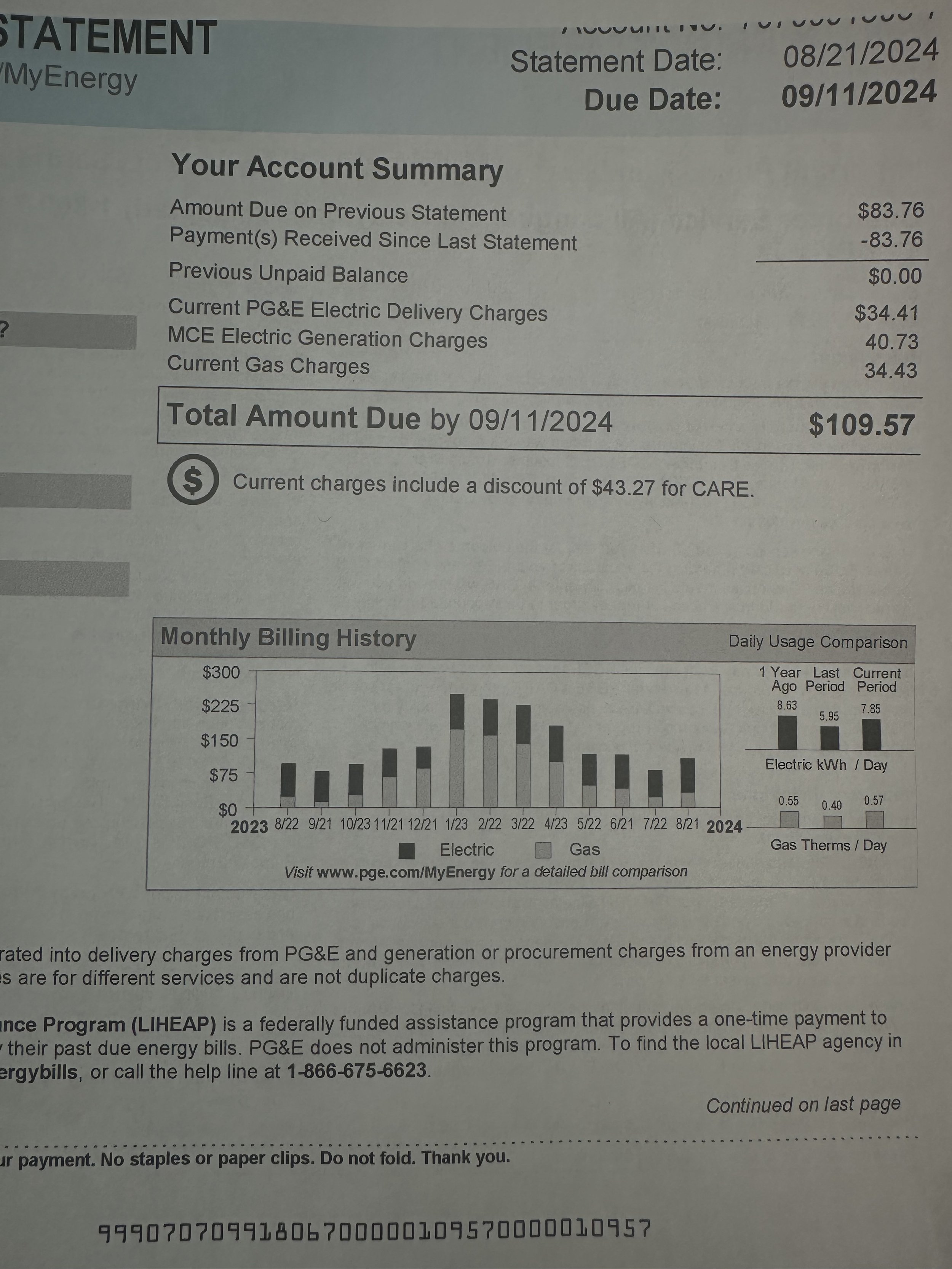How to Download PG&E Green Button Data: A Step-by-Step Guide
Are you interested in tracking your energy usage to optimize your solar installation or just get a better understanding of your electricity consumption? PG&E (Pacific Gas and Electric) provides a great tool called **Green Button** that allows you to download your detailed electricity usage data.
Here’s a simple guide to help you download your PG&E Green Button data and get started on tracking your energy usage.
What is PG&E Green Button Data?
PG&E’s Green Button program gives you access to your detailed electricity usage data in a secure and user-friendly format. This data can help you identify patterns, determine your peak usage, and even optimize your solar system to meet your energy needs.
Steps to Download Your PG&E Green Button Data:
1. Log in to Your PG&E Account
- Visit the PG&E website: [https://www.pge.com](https://www.pge.com).
- Click on the “Log In” button in the top right corner of the homepage.
- Enter your account information (username and password) and click “Sign In.”
2. Navigate to the Green Button Data Page
- Once logged in, go to the "My Energy"section of your account.
- From the menu, select “Energy Usage” or "Usage Data" (this may vary based on the version of the site).
- Look for an option to download your data using the Green Button. The button might be labeled as “Green Button Download” or “Download Usage Data.”
3. Choose Your Data Format
- PG&E allows you to download your usage data in two formats:
- CSV (Comma Separated Values) format, which is compatible with Excel or other spreadsheet software.
- XML (eXtensible Markup Language) format, which is useful for developers or for more advanced analysis.
- Choose the format that works best for you.
4. Select the Time Period
- You’ll be prompted to select the time range for your data download. You can usually choose from options like the last 12 months, last 30 days, or a custom date range.
- For solar purposes, downloading 12 months of data is usually ideal, as it gives a good snapshot of your annual usage patterns.
5. Download the Data
- After selecting your desired format and time period, click **“Download”**. Your data will begin to download to your computer.
6. Review the Data
- Once the download is complete, open the CSV and XML file using your preferred software (Excel, Google Sheets, etc.).
- The file will contain detailed information on your energy usage, including daily or hourly consumption in kilowatt-hours (kWh).
7. Use Your Data for Solar System Design
- This data can now be shared with your solar installer to help design a solar system that matches your exact energy usage. It can also be used to analyze your energy habits and look for areas to save.
Why is Green Button Data Important for Solar?
When you're considering going solar, your energy usage data is critical. The more accurate your data, the better your solar system can be designed to meet your needs. The Green Button data will help your solar installer assess:
- How much energy you use on a daily and monthly basis.
- When your peak usage times are (i.e., when you're using the most energy, which helps determine the size of your solar system).
- How much energy you’ll need to offset with solar panels.
Downloading your PG&E Green Button data is a simple and powerful way to take control of your energy usage. Whether you’re preparing for a solar installation or just want to track your consumption, having access to this data puts you in the driver’s seat of your energy decisions.
By following these easy steps, you’ll be ready to dive deeper into your energy habits and make informed choices for a more sustainable future.
California Utilities' New Fixed Charges: What It Means for Solar Customers and Your Energy Bill
PG&E Bill
In a recent decision that’s been met with mixed reactions, California’s major investor-owned utilities (IOUs) – Pacific Gas & Electric (PG&E), Southern California Edison (SCE), and San Diego Gas & Electric (SDG&E) – have announced a significant change to their pricing structure, with a new monthly fixed charge that will impact customers across the state. The move comes as part of the California Public Utilities Commission's (CPUC) efforts to balance the growing costs of grid maintenance and energy infrastructure. Let’s take a deeper dive into what this means for consumers and solar customers specifically.
The New Fixed Charge Structure
As of Q4 2025 for SCE and SDG&E, and Q1 2026 for PG&E, customers will see a new monthly charge on their energy bills, which will apply to all customers of the three large IOUs. Here’s a breakdown of the changes:
- $24.15 per month for all three large IOUs
This will be the standard fixed charge that applies to all residential customers, regardless of how much energy they consume.
- $6.00 per month for CARE customers
Low-income customers enrolled in California’s CARE (California Alternate Rates for Energy) program will pay a reduced rate for this new fixed charge.
- $12.08 per month for FERA customers
Customers enrolled in the FERA (Family Electric Rate Assistance) program, which serves middle-income households, will also receive a discounted rate.
While this monthly fixed charge may seem like a small increase at first glance, it can add up significantly over time, especially for customers who are currently benefiting from a more flexible pricing structure based on actual energy usage.
Impact on Solar Customers
For solar customers, this decision raises important considerations. Currently, many solar customers benefit from net metering, where they receive credits for the excess solar energy they produce and send back to the grid. This structure has been a key driver for people adopting solar energy, as it allows them to offset their electricity bills and make their investment in solar more financially viable.
However, with the new fixed charge, solar customers will likely see a shift in the way they are billed. The fixed charge means that regardless of how much energy they use or produce, they will still be required to pay this flat fee each month, which could make solar customers' bills less predictable. In essence, while you might still be saving money with your solar installation, your monthly utility charges won’t drop to zero as easily as before – even if you produce more energy than you consume.
Lower kWh Rates to Offset Increased Fixed Charges
In an attempt to balance the increased revenue from the new fixed charge, the utilities have agreed to lower their per-kWh rates. This means that the cost of electricity usage (based on the number of kilowatt-hours consumed) will decrease slightly:
- PG&E: 4.7 cents per kWh
- SCE: 4.6 cents per kWh
- SDG&E: 6.8 cents per kWh
For solar customers, this might offer a bit of relief on the energy side of the bill, as the cost per kWh will be reduced. However, the benefit might be overshadowed by the new fixed monthly charge, especially for those who rely on high energy usage and are accustomed to more variable costs.
What Does This Mean for the Future of Solar?
The introduction of a fixed charge is likely to prompt more discussions around how solar customers are compensated for their energy contributions to the grid. While the lower per-kWh rates may soften the blow, the increased fixed charge could discourage new solar installations for customers who were previously on the fence about making the jump. The unpredictability of utility bills, coupled with the loss of some savings from net metering, may make it harder for some people to justify the initial investment in solar.
However, for those who are already solar customers, this new fee could further highlight the importance of energy storage. With the ability to store excess energy in batteries like the Tesla Powerwall or other similar products, solar customers can reduce their dependence on the grid and avoid some of the impact of the new fixed charges. By maximizing self-consumption of solar energy, customers can reduce their grid reliance, keeping their utility bills lower despite the fixed charge.
While the rate adjustments by PG&E, SCE, and SDG&E are certainly a step toward addressing infrastructure needs and sustainability goals, they also underscore the need for more comprehensive solutions to incentivize clean energy adoption. With the fixed charge becoming the new norm, California residents and solar customers may need to rethink how they use and store energy to ensure they still benefit from their solar investments.
We recommend that solar customers consider evaluating their energy usage patterns and invest in home energy storage solutions if they haven't already. By doing so, you can continue to make the most of your solar system, even as the utility pricing structure evolves.
The new fixed charge proposed by PG&E, SCE, and SDG&E marks a significant shift in California’s energy landscape, and it’s a change that will impact all consumers, including those who have made the switch to solar. While lower per-kWh rates may provide some relief, the new fixed charge will likely make solar savings less predictable for many. As we head into 2025 and 2026, it’s more important than ever for solar customers to evaluate their energy needs, consider energy storage options, and stay informed about how these changes might affect their long-term energy costs.
If you're thinking about going solar or need to adjust your current system, now is a great time to talk to a professional who can help you navigate the upcoming changes and maximize the savings from your solar investment.
How to Build an ADU and Keep Your NEM 2.0 Solar Benefits: Our Recommendation
The rise in popularity of Accessory Dwelling Units (ADUs) in California is a trend that shows no signs of slowing down. Whether you're building an ADU for additional living space, a rental unit, or to house a family member, it’s important to understand how adding this new structure might impact your solar energy system, especially if you're currently taking advantage of **Net Energy Metering 2.0 (NEM 2.0).
NEM 2.0 is a key benefit for homeowners with solar systems, allowing them to earn credits for excess energy they send back to the grid. But when it comes to building an ADU, **adding a new unit with its own electrical meter could impact your solar savings and energy costs**. In this post, we’ll explore how NEM 2.0 works, why your ADU could affect it, and what we recommend to make sure you don’t lose your NEM 2.0 status
Understanding NEM 2.0: What It Means for Homeowners**
Net Energy Metering 2.0 (NEM 2.0) is a program offered by California utilities that allows solar homeowners to receive credit for the excess electricity their solar panels generate and send back to the grid.
-How it works: During the day, when your solar system generates more energy than you use, the excess power flows back into the grid, and you earn credits. At night, when your panels aren’t generating energy, you draw power from the grid, and those credits are used to offset your energy consumption.
- Why it’s valuable: Under NEM 2.0, you receive credits at the full retail rate for the energy your solar panels produce. This helps lower your electric bills, and over time, can significantly reduce the overall cost of your solar system.
However, if you're considering building an ADU, there are a few things to keep in mind regarding your solar energy system.
The Challenge: ADUs and Their Impact on NEM 2.0
Adding an ADU to your property means you’re adding another living space that will require its own energy usage. If your ADU is connected to the same electrical meter as your primary home, it will increase your overall energy demand. But here's the catch: If the ADU uses more power than your solar system is generating, you could lose some of the benefits of NEM 2.0.
When you add a new structure to your property, like an ADU, the utility companies may view the ADU’s energy consumption as part of your home’s total energy usage. This can create several complications:
1. Higher Energy Usage: The ADU’s additional energy consumption could push your home’s total usage above the amount your solar panels are generating. While you’ll still receive credits for the excess energy you generate, if the ADU uses more power than your panels can produce, you might need to buy more electricity from the grid.
2. Potential Impact on NEM 2.0: In some cases, if the ADU is not separately metered and is drawing power from the same meter as your primary residence, the utility may recalculate how your system’s credits and charges are applied. This could cause you to lose some of your NEM 2.0 benefits, especially if your total energy usage increases beyond what your solar system can offset.
Our Recommendation: Put the ADU on a Separate Meter
To ensure you don’t lose your NEM 2.0 status when building an ADU, we recommend installing a separate meter for the ADU. Here’s why:
- Separate Billing: If your ADU is on a separate meter, its energy consumption will be tracked separately from your primary home. This means the electricity used by your ADU won't count against the solar energy credits generated by your existing system.
- Retain Your NEM 2.0 Benefits: By keeping the ADU on a separate meter, your primary home’s energy consumption—and the amount of energy it sends back to the grid—will remain independent. You can continue to earn full credits for the energy your solar panels produce, without the ADU’s energy usage affecting your NEM 2.0 benefits.
- Flexibility: If the ADU is using a lot of energy (for example, if it has high-energy appliances, air conditioning, or electric heating), a separate meter allows you to manage each unit’s power use independently. This can help you avoid unexpected bills or disruptions to your solar energy credit balance.
Additional Benefits of a Separate Meter for Your ADU
Besides protecting your NEM 2.0 status, there are other financial and logistical advantages to putting the ADU on a separate meter:
- Clearer Energy Usage: You’ll have a more accurate picture of how much energy your ADU is using versus your primary home. This can help you assess whether the ADU is using more energy than expected and make adjustments (like adding more solar panels or improving energy efficiency) if needed.
-Future Flexibility: If you decide to rent out the ADU or sell your property, a separate meter can make it easier to track and allocate electricity costs, as well as create a clear distinction between the energy use of the primary home and the ADU.
Tax and Incentive Benefits: Depending on the energy programs available, a separate meter might help you qualify for certain incentives or tax credits related to the energy efficiency of your ADU.
Final Thoughts
Building an ADU is a fantastic way to add value to your home and increase living space, but it’s essential to keep an eye on how it impacts your solar energy system and your NEM 2.0 benefits. By installing a separate meter for the ADU, you can avoid complications with your solar credits and ensure that you continue to reap the rewards of your solar investment.
At Rooftop Solar, we specialize in helping homeowners maximize the benefits of their solar systems, whether they’re building an ADU or just looking to optimize their current setup. If you’re planning to build an ADU and want to ensure your solar system is set up for success, feel free to contact us. We’ll guide you through the process and help you protect your NEM 2.0 status while you add that extra space to your home.



